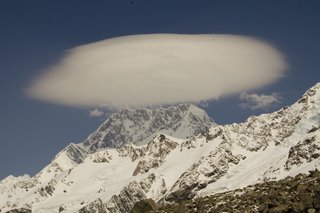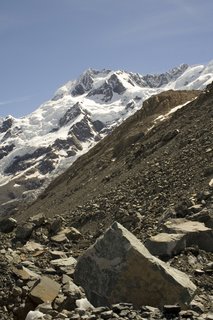
Our field site was Tasman Glacier, which is New Zealand's longest glacier with a total length of 25 km. Its upper accumulation area has an elevation of over 3000 m and is thought to receive something like 12 m of precipitation a year. The glacier is within Aoraki/Mt. Cook National Park and is popular tourist destination for climbers, especially those wishing to climb Aoraki, the highest peak in Australasia. I prefer the Maori name "Aoraki" because it was the first name given to peak and it is a beatiful and appropriate name - meaning "cloud piercer". We had a nice view of the summit of Aoraki from our hut and often observed it piercing the clouds.

Only rarely does field work involve staying in a hut, and it was a real treat, especially during periods of rainy, windy weather. The huts in Aoraki/Mt. Cook National Park are all equipped with radios, and this allowed us to get weather reports and to arrange for a helicopter to pick us up when we finished our work.
Here's a view of the inside of the hut.

The field work was greatly complicated by the fact that the Tasman Glacier has thinned significantly over the past 100 years. The hut is now located some 100 m above the glacier, and the only way to access it is to scramble up a steep, unstable moraine. It wasn't quite steep enough to require the use of a rope, but if you picked the wrong route (as I did on two occasions) you would find yourself wishing that you had one. The photo below shows the moraine that we could to scramble up and down everyday, sometimes carrying heavy equipment, food, or our toilet.

No comments:
Post a Comment